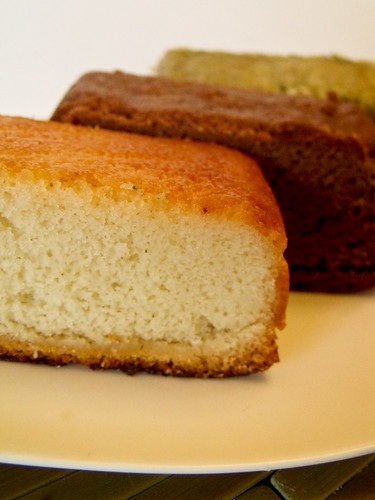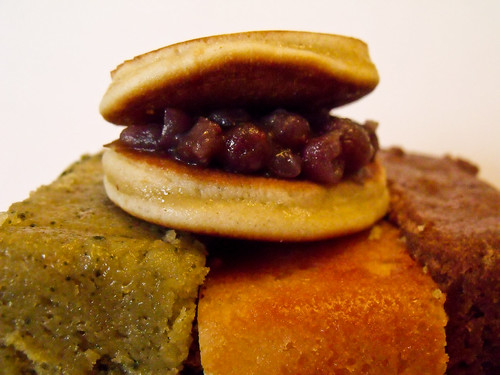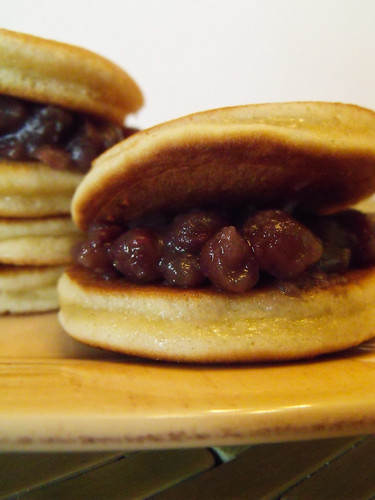Boy, did you guys prove me wrong. Last I heard, the amount of money donated has reached $8,169. I'm still waiting to hear how much our truffles made, but I've been told it's in the $150 range. Which blows my mind. The generosity of all the bidders was absolutely outstanding. All of you absolutely rock! We can not thank you enough! I know, when we send out our truffles to the winner, we'll be packing their box full of love (and some other neato things).
All this generosity inspired me to share a couple of Japanese desserts for our next Journey Around the World (of Cake):
Japanese Kasutera Cake
So what is it? Kasutera is an extremely popular Japanese sponge cake. You can usually find it in skinny little boxes, piled high in the sweets aisle or your local Asian supermarket. These cakes have to be perfect - perfectly straight, perfectly shaped, perfectly light, perfectly sweet - or the regular Kasutera eatter will snub it. The fun thing about this cake is it lends well to different flavouring. Honey is the most common of flavour, but chocolate and matcha are also welcomed.
When did it first pop up? This type of cake actually came from the Iberian peninsula. Portuguese sailors most likely brought it over during the Spanish kingdom's naval boom in the Middle Ages. These sailors were eventually kicked out of Japan (probably for being big jerks), but the cake stayed. Castella, or "the bread of Castile" made it into the Japanese vocabulary as Kasutera.
Is it worth my time? Like any sponge cake, Kasutera is extremely picky. The eggs have to be whipped up perfectly, or the cake will fall flat like a pancake and have a pretty gross texture. If you follow all the steps perfectly, however, you'll be left with a cake that will have an extra special place in your heart. Mr. C claimed that this is now his favourite recipe - and that's saying something.
Got a recipe? Only if you promise to be good:

Japanese Kasutera Cake 2 cups sugar 3 Tablespoons milk 1/4 cup honey 8 eggs 2 cup cake flour (sifted) 1 ounce semi-sweet chocolate (chopped fine and melted) 1 Tablespoon matcha powder
1) Preheat the oven to 350F. Butter three loaf pans, then line the pans with parchment paper. Butter the paper and sprinkle with a little sugar.
2) Combine the milk and honey in a sauce pan over low heat. Stir constantly until the mixture is just ready to boil. Remove from heat and set aside.
3) Beat the eggs with an electric mixer with an whisk attachment until they become foamy (about 1 minute). Slowly add the sugar and continue mixing until the mixture thickens and turns pale yellow. Add the milk and honey mixture and beat until really creamy (about 3 minutes). Add the flour gradually and beat on slow until the mixture becomes a thick batter (about 2 minutes).
4) Separate your batter evenly between three bowls. In one bowl, whisk in your melted chocolate. In a second bowl, whisk in the matcha powder. Leave the third bowl honey flavoured. Pour each batter into it's own loaf pan. Bake for 8 to 10 minutes on the upper rack of your oven. Then tern the temperature down to 325 and continue to cook on the lower rack of your oven for 30 to 40 minutes - or until your cake tester comes out clean. Turn the heat off and leave the cakes in the oven for about 10 more minutes with the door slightly ajar. Remove the cakes and take them right out of the pan by lifting the parchment paper. Peel off the parchment paper and trim the sides of the cake. Serve while warm, or cover immedently in plastic wrap and store in the refrigerator.

Japanese Dorayaki
So what is it? You may see these guys hanging around with cute little anime characters. A popular snack food treat, dorayaki consists of two little sweet pancakes (made from a form of Kasutera cake) with red bean paste in the middle. Again, this stuff can be found in your local Asian supermarket, but they are oh so much better when made from scratch at home.
When did it first pop up? Legend has it that a samurai, who was on the run, left his gong at a farmer's house while trying to escape from enemies trying to track him. The industrious farmer used the gong to make pancakes on - "Dora" meaning "gong" in Japanese. Pretty cool legend for a cake, eh? I'd like to see Nanaimo Bars beat that one.
Is it worth my time? If you'd made pancakes, then you'll have no problem making these. They are great little snacks for lunch boxes or a get together. Easy process and tasty payout. If you're not into making your own red bean paste (which does take a day or two), just run out and buy some from your Asian grocery. While you're there, pick up some black sesame seed paste - dorayaki goes super with that stuff too.

Japanese Dorayaki with Red Bean Paste 1/2 cups + 2 Tablespoons of adzuki beans (soaked overnight and drained) 1 cup sugar 1/2 teaspoon salt
3 eggs 1/2 cups sugar 1/2 teaspoon baking soda 3 Tablespoons milk (warmed) 1 cup all-purpose flour (sifted) 1 teaspoon vanilla 2 Tablespoons vegetable oil
1) To make the red bean paste: cover the beans with water in a large pot and bring to a boil. Reduce the heat and simmer for a bout 15 minutes. Drain the water, then return the beans into the pot with fresh water. Bring to a boil, then reduce the heat and simmer for about one to one and a half hours, until the beans are really soft. Drain, then return the beans to the pot. Pour in 1 cup sugar and 1/2 teaspoon salt and cook over low heat, stirring when necessary, until mixture is thick and chunky. Cool and store in an airtight container until ready to use.
2) To make the pancakes: Beat the eggs and the sugar with a mixer until creamy. Add the vanilla. Dissolve the baking soda in the milk, then add the milk to the egg mixture. Stir until combined, then slowly blend the flour into the egg mixture.
3) Warm the oil in a large skillet over medium hit. Pour the batter into the skillet in about 2-inch rounds. Cook just like pancakes - when bubbles start to appear on the top surface of cake, flip it over. Cook until they are golden on both sides. Repeat with the rest of the batter. Let the cakes cool, then fill with the red bean paste. Enjoy!
Journey Around the World (of Cake) Map
Is it worth my time? Like any sponge cake, Kasutera is extremely picky. The eggs have to be whipped up perfectly, or the cake will fall flat like a pancake and have a pretty gross texture. If you follow all the steps perfectly, however, you'll be left with a cake that will have an extra special place in your heart. Mr. C claimed that this is now his favourite recipe - and that's saying something.
Got a recipe? Only if you promise to be good:


Japanese Dorayaki
So what is it? You may see these guys hanging around with cute little anime characters. A popular snack food treat, dorayaki consists of two little sweet pancakes (made from a form of Kasutera cake) with red bean paste in the middle. Again, this stuff can be found in your local Asian supermarket, but they are oh so much better when made from scratch at home.
When did it first pop up? Legend has it that a samurai, who was on the run, left his gong at a farmer's house while trying to escape from enemies trying to track him. The industrious farmer used the gong to make pancakes on - "Dora" meaning "gong" in Japanese. Pretty cool legend for a cake, eh? I'd like to see Nanaimo Bars beat that one.
Is it worth my time? If you'd made pancakes, then you'll have no problem making these. They are great little snacks for lunch boxes or a get together. Easy process and tasty payout. If you're not into making your own red bean paste (which does take a day or two), just run out and buy some from your Asian grocery. While you're there, pick up some black sesame seed paste - dorayaki goes super with that stuff too.
Got a recipe? Only if you make extra for me.




4 comments:
I love love these recipes
Wow, I've never heard of either of these! I think my family would like the Kasutera cake. Congrats on your truffles! I'm hoping someone bid on my cookies :)
Sounds delicious!
San Diego Mobile Notary
Smile. My best friend is teaching in Japan. I want to make something sweet in her honor. Thank you for sharing, for creating, and for inspiring me to remember all the beauty and good in this world. Many blessings tomorrow and in the days to come this week.
Post a Comment